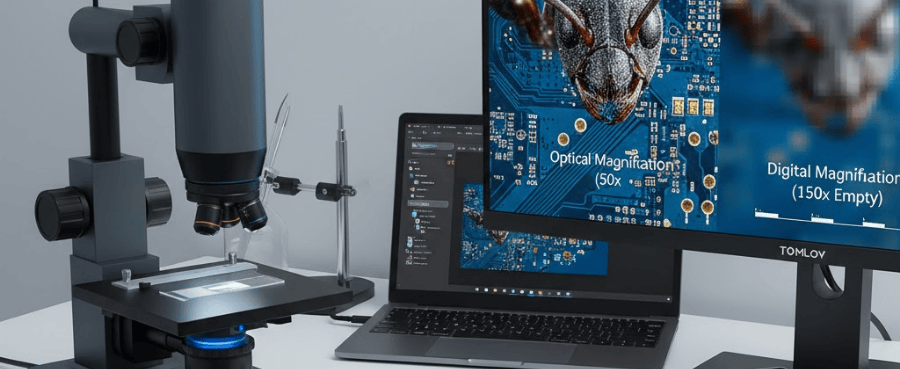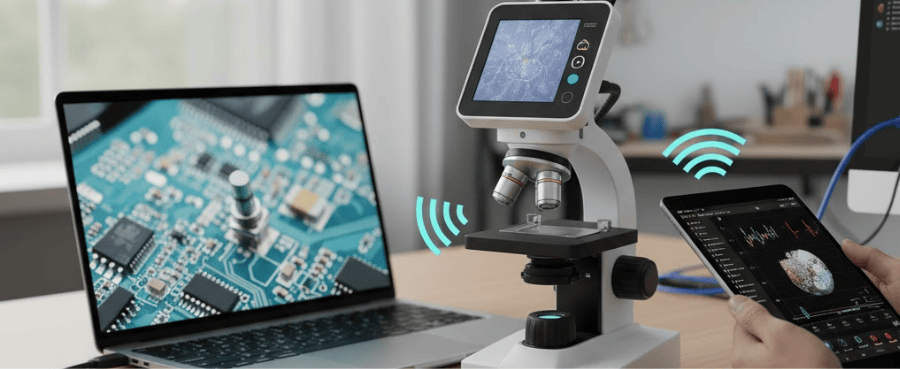40x provides a broad overview, ideal for locating and framing your specimen; 100x reveals detailed cellular structures; 400x exposes delicate features, such as individual cells and tiny microorganisms.
As magnification increases, your field of view and depth of field both shrink, so you see less area but far more detail.
This guide explains exactly what you’ll see at each level and how to choose the right setting for your sample.
Magnification at a Glance
|
Magnification |
Field of View |
Best For |
What You'll See |
|
40x |
Widest |
Scanning slides, finding specimens |
Overall shape of large cells, tiny insects |
|
100x |
Medium |
General observation |
Structure of cell groups, larger protozoa |
|
400x |
Narrowest |
Viewing fine details |
Individual bacteria, details within cells |
How to Calculate Microscope Magnification
A compound microscope uses two lenses to magnify a specimen: the eyepiece lens you look through (typically 10x) and the objective lens on the rotating turret (4x, 10x, 40x, etc.).
To find the total magnification, simply multiply the two:
- 40x Total Magnification: (10x Eyepiece) * (4x Objective)
- 100x Total Magnification: (10x Eyepiece) * (10x Objective)
- 400x Total Magnification: (10x Eyepiece) * (40x Objective)
A Beginner's Guide to Magnification: What You'll See at 40x, 100x, and 400x
40x Magnification: Your Starting Point And Wide View
At 40x total magnification (using a 4x objective with a 10x eyepiece), you get the widest field of view. This is your go-to starting point for every observation.
- What It's For: Think of 40x as your "map view." It's perfect for scanning an entire slide, locating your specimen, and getting it roughly centered. You can observe larger objects like insect wings, tiny pieces of fabric, or even a whole small plant section. You'll see the overall shape and arrangement of larger cells, but don't expect intricate details.
- Practical Tip: Always start with 40x. It makes finding your specimen much easier before you zoom in further.
Example of 40x View: Imagine looking at a tiny insect through a magnifying glass. You see the whole thing, but individual hairs are still indistinct.

100x Magnification: Zooming In For General Observation
Switching to 100x total magnification (using a 10x objective with a 10x eyepiece) significantly reduces your field of view but brings objects closer.
- What It's For: This is your "intermediate" power. It's excellent for observing the general structure of larger cells, like onion cells or cheek cells, and seeing how they are arranged. You may discern the outlines of organelles within cells or spot larger protozoans moving in pond water. Bacteria may appear as very tiny dots.
- Practical Tip: Once you've found and centered your specimen at 40x, simply rotate the objective turret to 100x. You'll likely only need to adjust the fine focus knob slightly.
Example of 100x View: Now you've zoomed in on a section of the insect wing. You can clearly see the veins and the texture of the membrane, but not yet the cells that make it up.

400x Magnification: Discovering The Fine Details
At 400x total magnification (using a 40x objective with a 10x eyepiece), your field of view is much smaller, but the level of detail is dramatically increased.
- What It's For: This is where things get exciting! You'll be able to observe fine cellular details, such as the distinct shapes of bacteria (cocci, bacilli, spirilla), individual red and white blood cells, and the intricate structures of protozoans like amoebas or paramecia. You can often see nuclei and other larger organelles within plant and animal cells.
- Practical Tip: At 400x, the depth of field (the thickness of the specimen that appears in focus) is very shallow. You'll need to continuously use the fine focus knob to explore different layers of your specimen. You'll also likely need to increase the light intensity.
Example of 400x View: At this level, you can see individual cells and even some cellular structures within the insect wing membrane.

Common Pitfall: Why More Magnification Isn’t Always Better
Many beginners think that a microscope with the highest possible magnification is always the best. However, this isn't true! Magnification is only one piece of the puzzle. The true hero of clear viewing is resolution.
Understanding Resolution: Clarity Is Key
- Resolution refers to the ability to distinguish between two closely spaced objects. If your resolution is poor, a highly magnified image will just look like a bigger, blurrier mess.
- Numerical Aperture (NA): This specification on your objective lens indicates its ability to gather light and resolve fine details. A higher NA means better resolution.
- The Bottom Line: A well-designed 400x objective with good resolution will provide a much more precise and more useful image than a cheaply made 1000x objective with poor resolution. Don't fall for inflated magnification numbers without considering resolution!
Practical Tips For Your First Observation
Whether you have a traditional model or a modern tomlov digital microscope, you understand the magnification levels – now let's get you viewing
How To Properly Change Magnification
This is a critical skill for clear, stress-free viewing:
- Start at 40x (4x Objective): Always begin here. Place your specimen on the stage, turn on the light, and use the coarse focus knob (the larger one) to bring the image into focus. Center the part of your specimen you want to examine more closely.
- Rotate to 100x (10x Objective): Gently rotate the revolving nosepiece until the 10x objective clicks into place. Do not use the coarse focus knob anymore! Use only the fine focus knob (the smaller one) to sharpen the image.
- Rotate to 400x (40x Objective): Again, gently rotate the nosepiece until the 40x objective clicks. Fine-tune the focus with the fine focus knob. Adjust the light intensity using the dimmer or the iris diaphragm to get the best contrast.
Optimizing Your View At Higher Powers
- Light is Your Friend: As you increase magnification, the image becomes dimmer because the light is spread over a larger area. Increase your light source intensity and adjust your condenser and iris diaphragm for optimal brightness and contrast.
- Fine Focus is Key: At 400x, the depth of field is very shallow. Continuously (and slowly!) turning the fine focus knob back and forth will allow you to "scroll" through different layers of your specimen, revealing details at various depths.
- Keep it Clean: Dust or smudges on your eyepiece or objective lenses will become hugely magnified! Always use proper lens cleaning paper and solution to keep your optics pristine.
Tomlov.com is a premier destination for high-quality digital microscopes that serve a diverse audience, from curious hobbyists to technical professionals. The company specializes in providing innovative and user-friendly imaging tools for applications like coin collecting, electronics repair, and educational exploration.
By offering advanced microscopy technology at an accessible price point, Tomlov empowers everyone to discover the details of the world unseen.
Related Reading:Are digital microscopes worth it?
Step-By-Step Decision Guide: Choosing Your Microscope
Use this guide to help you decide which magnification capabilities are right for your needs.
- What's Your Primary Use?
- "I want to explore everyday objects, larger insects, and pond water organisms. My kids are learning about cells."
- Decision: A microscope with up to 400x magnification (4x, 10x, 40x objectives) is perfect.
- "I'm a serious hobbyist, maybe want to dabble in microbiology, or need to see bacteria clearly."
- Decision: A good quality microscope with 400x magnification is still your primary tool, but consider one with an optional 100x objective for oil immersion if you want to push into advanced bacterial viewing. Be prepared for extra steps and cleaning.
- "I'm in a professional lab, or doing very advanced research requiring detailed bacterial/viral analysis."
- Decision: You'll need a professional-grade microscope with high-quality 1000x oil immersion capabilities, and likely advanced features like phase contrast or fluorescence.
What's Your Budget?
- Entry-Level (Under $200): Expect up to 400x magnification. These are great for beginners and students.
- Mid-Range ($200-$500): You'll find higher quality optics at 400x, and some might include a 100x oil immersion objective.
- High-End ($500+): Professional-grade instruments with superior optics and advanced features for serious work.
Are You Comfortable with More Advanced Techniques (like oil immersion)?
- "No, I want something easy to use."
- Decision: Stick to a microscope that goes up to 400x.
- "Yes, I'm eager to learn more complex methods."
- Decision: Consider a microscope that includes a 100x objective for oil immersion, but be aware of the extra steps.
By following these steps, you can confidently choose a microscope that meets your needs without overspending or being disappointed by features you won't use.
Frequently Asked Questions (FAQ)
Can I see bacteria with a 400x microscope?
Yes, you can generally see bacteria as small dots or distinct shapes (like rods or spheres) at 400x magnification. To see wonderful internal details of bacteria, 1000x with oil immersion is usually preferred.
What's the main difference between magnification and resolution?
Magnification is how much an object is enlarged, making it appear bigger. Resolution is the ability to see fine details and distinguish between two separate points. A high magnification with poor resolution will result in a blurry, large image.
Why do I always start focusing at 40x magnification?
You start at 40x because it provides the widest field of view, making it much easier to locate your specimen on the slide. Trying to find a tiny object at 400x is like trying to find a needle in a haystack!
Do all microscopes come with 40x, 100x, and 400x settings?
Most compound (biological) microscopes designed for educational or hobbyist use will include 4x, 10x, and 40x objective lenses, giving you total magnifications of 40x, 100x, and 400x (with a 10x eyepiece). Some may also include a 100x objective for 1000x oil immersion.
Is a 400x microscope good enough for a child's science fair project?
Absolutely! A 400x microscope is excellent for most science fair projects involving cells, pond life, plant structures, and basic microbiology. It provides plenty of detail for engaging and educational observations.
In Conclusion
Remember the crucial trade-off: as you increase magnification, you gain detail but lose your field of view. More importantly, a clear image depends on resolution, not just magnification. A sharp 400x view will always reveal more than a blurry, over-magnified image. By understanding these principles, you're well-equipped to explore the fascinating microscopic world with confidence.




Laisser un commentaire
Tous les commentaires sont modérés avant d'être publiés.
Ce site est protégé par hCaptcha, et la Politique de confidentialité et les Conditions de service de hCaptcha s’appliquent.